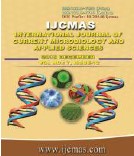


 National Academy of Agricultural Sciences (NAAS)
National Academy of Agricultural Sciences (NAAS)

|
PRINT ISSN : 2319-7692
Online ISSN : 2319-7706 Issues : 12 per year Publisher : Excellent Publishers Email : editorijcmas@gmail.com / submit@ijcmas.com Editor-in-chief: Dr.M.Prakash Index Copernicus ICV 2018: 95.39 NAAS RATING 2020: 5.38 |
A field experiment was conducted for three consecutive years commencing from 2011-12 to 2013-14 at Agronomy farm, College of Agriculture, Dapoli Dist. Ratnagiri, Maharashtra, India to study the Effect of irrigation and levels of fertilizer application on zero tilled cowpea (Vigna unguiculata L.). The experiment was laid out in a split plot design with three replications. The main plot treatments were three irrigation levels, viz., no irrigation (I0), one irrigation at branching (I1) and two irrigations at branching and pod filling stage (I2). The sub plot treatments comprised six fertilizer levels viz., no fertilizer (F0), 25% RDF below seed placement (F1), 50% RDF below seed placement (F2), 75% RDF below seed placement (F3), 100% RDF below seed placement (F4) and 100% RDF through line application (F5). Thus, there were in all 18 treatment combinations. The gross plot size was 4.2 m x 3.3 m and net plot size was 3.6 m x 3 m, respectively. The soil of the experimental plot was uniform, leveled and well drained. It was sandy clay loam in texture, medium in available nitrogen (298.20 kg ha-1), low in available phosphorus (11.80 kg ha-1), moderately high in available potassium (249.35 kg ha-1), medium in organic carbon (0.95%) and slightly acidic in reaction (pH 5.8). Results revealed that application of two irrigations (at branching and pod filling stage) recorded significantly higher growth as well as yield attributes resulting in higher grain and stover yield followed by treatment in which one irrigation (at branching) and control treatment. Application of 100% RDF below seed placement recorded significantly higher growth as well as yield attributes resulting in higher grain and stover yield followed by 100% RDF through line application and 75% RDF below seed placement over rest of the treatments. In respect of economics, it was observed that the treatment combinations I2F4 (two irrigations at branching and pod filling stage + 100% RDF below seed placement) has given highest net returns and B: C ratio.
 |
 |
 |
 |
 |